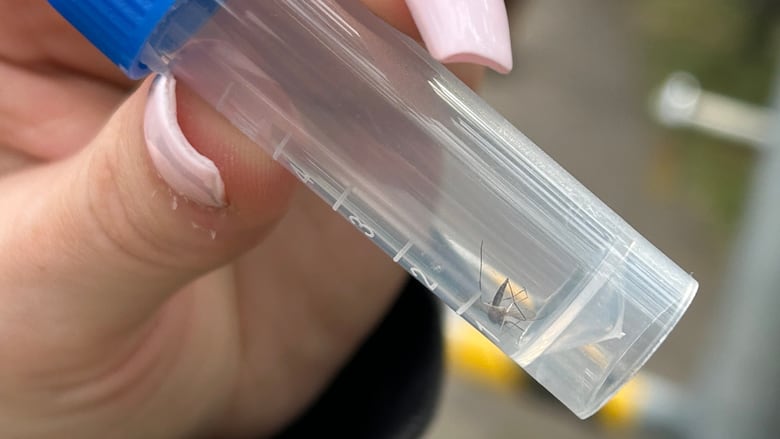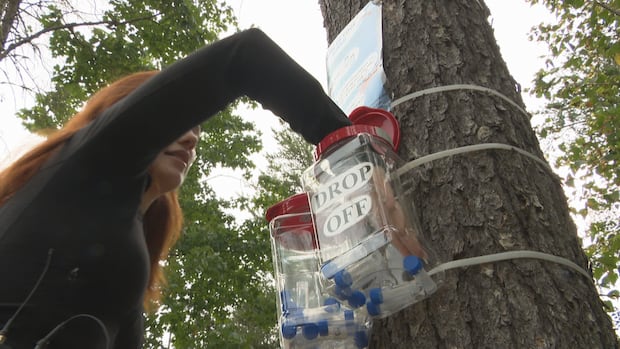New Brunswickers trap mosquitoes all summer for scientific study
Acadia University biology group tracks invasive species, diseases

It's not often that you kill a mosquito with perfection without squishing it or making it lose a wing or a leg.
This summer, some New Brunswickers displayed their talent for smacking the tiny pest just hard enough to make it faint, with some even catching them alive using a small bottle.
This was not just a fun summer pastime.
It's all part of a study on mosquitoes led by a group of researchers from Acadia University.
They asked people who visited Riverview's Mill Creek Nature Park and the Kouchibouguac National Park to help them gather mosquitoes as part of their project looking at the effects of climate change on the mosquito population.
Empty vials were provided at stations at both locations.
Once a mosquito was successfully caught, participants were asked to put it into the vial and drop it off at the same station.
The activity is one of the three methods that Acadia University students are using to research and develop a mosquito surveillance network, said Laura Ferguson, professor of biology.
She said the research will help update the historical data, learn how climate change is affecting mosquitoes and find new invasive species across the Maritimes.
"We have about 40 species in the Maritimes and we have enjoyed a very sort of low risk of mosquito-borne disease here for a long time," she said.
"But as things start to warm up, we're expecting some changes in our mosquito populations. And so what we really want to do is be proactive and keep an eye on things, and detect any changes before they start to hit us hard."
The community engagement stations were only set up at the two New Brunswick locations in June and July, but collections began in Nova Scotia in May 2021, she said.

The group used stick apparatus called dippers to scoop out mosquito larvae from water, and light traps containing carbon dioxide were used to bait adult mosquitoes in Nova Scotia, said Ferguson.
She said the group later expanded their collection area to New Brunswick and Prince Edward Island, and all are coming to a conclusion this fall.
"We have graduate students and undergraduate students who are out through the collection season ... basically May through October, and they are travelling all around the Maritimes and they are hard at work," she said.
New Brunswickers exceeded expectation
Lillian Ricker, an undergraduate student with the mosquito group, has been maintaining the two New Brunswick stations all summer.
Ricker plans to take them down over the Labour Day weekend and said the participation from the community has exceeded her expectations.
"It has been very fulfilling. Honestly, I didn't expect the amount of participation that we have gotten."

"Coming and seeing how much people were willing to help and put in their part for the community, it was very satisfying," Ricker said, mentioning that drop-off bins were full week after week.
On Wednesday, she refilled her last batch of empty vials and collected all the dead mosquitoes. She later examined the deposits, bottled them together, labelled the vial and put it in her freezer.
She said the cold will reduce the moisture and keep the mosquitoes fresh until she takes them back to the research lab in Wolfville, N.S.
The vials are packed with tiny silica gel beads underneath the cap to absorb moisture, but Ricker said hot temperatures during the summer made some of the collections in the boxes moldy and unusable.
Some people went a step further and deposited ants or blackflies in the vials, she laughed.

"For the most part, people do put mosquitoes, but I have gotten in a vial once, three horseflies," she said.
"I don't know how they managed to get three horseflies in one vial. I can barely even kill one. So that was definitely funny to see. It was impressive."
She said some mosquitoes are submitted intact and it is easier to determine their species. Others arrive squished or missing legs, but they are still studied using molecular techniques in the lab.
"It is kind of hard to tell their head from their abdomen sometimes."
'Not every mosquito is after a human'
Ferguson said the most exotic mosquito species that her group has found in the Maritimes originated from Japan.
It may have travelled by laying eggs in tires and its population has exploded in Nova Scotia, she said. This species is also found in New Brunswick and P.E.I., and may be a carrier of the West Nile virus, which her group is keeping an eye on.
"We have a student who is working on creating some really beautiful maps of where certain species are located across the Maritimes."
Ferguson said there is an interesting species with "iridescent blue scales" that feeds on earthworms and leeches, and another that only feeds on amphibians.

"So not every mosquito is after a human, although like I said, it certainly feels like it sometimes."
She said her team has already compiled some data for Nova Scotia and will publish it in the fall, while they continue working on the New Brunswick and P.E.I. data, which could be expected in 2025, or the following year as a database.
She said the group hopes to expand the community engagement project next year by having collection bins in more locations.
"Keep an eye out in your local areas through the next mosquito-collection season," said Ferguson.


